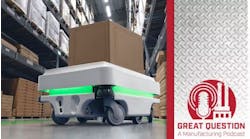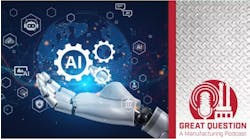Two distinguished guests, Marcel van Helten, president of Red Lion Controls, and Craig Resnick, VP of consulting for ARC Advisory Group, join Smart Industry’s Scott Achelpohl for an informative discussion about easing the information overload and better accessing data to aid digital transformation.
Video: Taming data and no-nonsense ways to drive your digital transformation
As the title suggests, these thought leaders almost immediately delved into lots of topics related to data: quality and accessibility and how those make all sorts of things manufacturing companies frequently seek to do possible—like automation, sustainability initiatives, AI, predictive maintenance, and OT visibility and security—that all require intact information and lots of it.
Survey: Almost all manufacturers struggle with making use of data
Below is an excerpt from the podcast:
Smart Industry: Would you agree that data is the most significant challenge for a manufacturer looking to advance in its digital transformation journey, whether it's, for example, automating a factory or making use of AI, or trying to establish a predictive maintenance program?
Craig Resnick: There's absolutely no question, Scott. Think of it like this. If you don't have power, you can't power your home, you can't power an office building. You can't drive a vehicle without either fuel or, you know, obviously a charged battery.
See also: Future-proofing your operations: Automation support through the looming labor crisis
Data is what makes the world go round. But what if the data is not available? If the data is not correct or if the data is not helpful to you, it doesn't really matter. You can't go forward with your digital transformation journey. You can't achieve what we like to say at ARC is a single version of the truth. You're not going to have access to the information or the data that you need to give you the information or give your machines the information to make the decisions that need to be made to help operate any sort of business.
I mean, think of it. In this world, people are able to add a wide variety of sensors to a variety of assets, let's say rotating assets for example, to do things such as asset management as part of IoT. But for you to be able to calculate if that asset is, you know, running, or how it is performing, you need data.
If you don't have the right data, aren’t getting it from the right places, aren’t doing the right level of analytics on that data, and don’t have the analytics tools to be able to convert that data into meaningful information that other machines or people can use to make the right decision because it's being presented to the machine and presented to the person in that appropriate manner, you can't do things like preventative maintenance.
Podcast: How AI, cybersecurity, and sustainability are impacting asset management
You can't try to eliminate unscheduled downtime. You can't do artificial intelligence if you don't have the right data to be able to put together the right algorithms to make the right decisions. So ultimately, if you have no data, you have no fuel. I know sometimes people like to use that analogy that, you know, data is the energy of today. It’s a valuable commodity. When companies are purchasing companies, for example, what's the biggest asset they're looking to purchase? It’s the data.
Marcel van Helten: I agree. A wise man once said, “Without the data, you're just somebody else with an opinion.” Getting the data itself is not a big challenge. I mean, we do that as an industrial data company relatively easy.
Getting the right data at the right time and also making sure you got the complete data, for that you really need to bridge the gap between what is the outcome I'm looking for and then work that back through the manufacturing plant and say, “What points of data are really critical to deliver that output?”
That is what I think is going to be the challenge. What is exciting about industrial automation is we have got a whole new group of people coming in, data analysts. People are understanding AI, but they're not necessarily versed in what is a manufacturing plant and what is the manufacturing process. So I think the key thing is bridging those two things together and really understanding what sort of input do I need to achieve the outcomes, and then the technology in the middle is not that difficult. That's been around for a long, long time. But I think that that matchup is critical.
Smart Industry: What would you specifically recommend as some steps and strategies to combat the problem of poor data quality?
Craig Resnick: In many cases, we say it's drowning in data. What happens is you're collecting so much data, and it's assessing what is the value of that data as far as for, again, making decisions to help run an enterprise. Have you been collecting data for the sake of collecting it? You really need to assess where all that data is coming from. What type of information is it presenting? Is it being analyzed? Is it working in conjunction with other data and information that's able to show, as we mentioned earlier, a single version of the truth. Because that's the idea. Let's not drown in data that is not constructive. It's not going to help a company or people or machines make the right or best decisions.
See also: Inside the Rockwell, Church & Dwight OT cybersecurity team-up
One of the things we also do, because it's something we get involved with very heavily at ARC, is going through the plants and doing these plant audits. We're looking at things where, you know, the typical company has systems ranging from state-of-the-art to 20 to 30 years old.
Sometimes they're connecting on, talking on proprietary networks that would not meet today's criteria of open standards. It could even be older OPC connections going back to, say, OPC DA, for example. The idea is you really have to start with a strong, solid foundation. What are you collecting? How can it be used? Does it need to be conditioned? Does it need to be cleansed? Where is that data going?
There was a time when typical data collection was going to other automation assets. For example, maybe it's sensors going to a PLC or a pack or a DCS system. But now, especially with the asset performance management and collecting a lot of that IoT data, again, is it giving you something that's going to help you avoid downtime or be able to predict when maintenance needs to be done? But if it's just collecting for the sake of collecting it, then that's really when you need to, you know, put together that solid data strategy.



